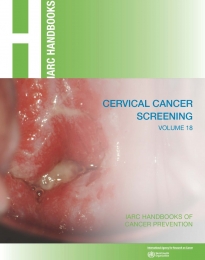
978-92-832-3025-0
978-92-832-3024-3
View summary report as HTML or PDF
View French version of The NEJM summary (hosted by Centre Léon Bérard)
A Working Group of 27 independent international experts, convened by the International Agency for Research on Cancer (IARC) between June and October 2020, reviewed the scientific evidence and assessed the cancer-preventive and adverse effects of various methods of screening for cervical cancer. Cervical cancer is the fourth most commonly diagnosed cancer type in women worldwide, and the fourth most common cause of cancer death in women.
This publication is an important update of the previous IARC Handbook on cervical cancer screening (Volume 10, published in 2005). Volume 18 provides evidence-based evaluations of the effectiveness of five methods of cervical cancer screening in reducing cervical cancer incidence and/or mortality. The Working Group also reviewed the body of evidence and provided conclusive statements on the comparative effectiveness of those screening methods that are established to reduce cervical cancer incidence and/or mortality. In addition, the Working Group provided an updated literature review on the determinants of participation in screening programmes and on emerging techniques, as well as on the different categories of women at differential risk and the surveillance strategies for such women.
2. Cervical Cancer Screening Programmes
3. Participation in Screening for Cervical Cancer
4. Preventive and Adverse Effects of Cervical Cancer Screening
4.2 Screening by visual inspection
5. Screen-and-Treat Approach and Women at Differential Risk
Web-only tables
Table 4.36 Meta-analysis and reviews to evaluate the accuracy of colposcopy as a diagnostic method
Table 4.37 Risk of cervical precancer based on the results of screening and follow-up tests
Box S1 PICOS components of the research question
Fig. S1 PRISMA flow diagram showing the retrieval and selection of studies